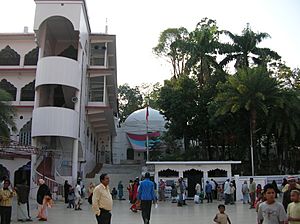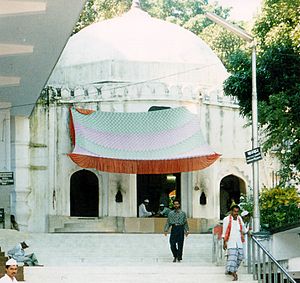Shah Jalal facts for kids
Quick facts for kids Jalāl Mujarrad Kunyāʾī |
|
|---|---|

Shah Jalal's grave in the Shah Jalal Dargah, Sylhet
|
|
| Religion | Sunni Islam |
| Philosophy | Sufism |
| Other names | Shah Jalal |
| Personal | |
| Born | 25 May 1271 Disputed, see below |
| Died | 15 March 1346 (aged 74) Sylhet (now in Bangladesh) |
| Resting place | Shah Jalal Dargah |
| Parents |
|
| Relatives | Jalaluddin Surkh-Posh Bukhari (maternal grandfather) |
| Senior posting | |
| Based in | Jalalabad |
| Predecessor | Syed Ahmed Kabir Suhrawardi |
| Successor | Shaykh Sayyid Farhan bin Muhammad Al-Hadhrami Al-Yemeni Shah Paran |
| Religious career | |
| Post | Sufi saint, religious leader and mystic |
Jalāl Mujarrad Kunyāʾī, known to many as Shah Jalal, was a very important Sufi leader in Bengal (an area that includes modern-day Bangladesh and parts of India). He is famous for helping to spread Islam in the region. His name is also linked to the Conquest of Sylhet, a big event in history. Many places, like the largest airport in Bangladesh, Hazrat Shahjalal International Airport, are named after him.
Contents
Where was Shah Jalal Born?
Shah Jalal was born on May 25, 1271. People have different ideas about where he was born. Some old stories and local songs call him Shah Jalal Yemeni, suggesting he came from Greater Yemen.
However, an old writing from around 1505 AD calls him Kunyāʾī. Some experts think this means he was from Konya in modern-day Turkey. Others believe it refers to a village in Yemen or even Kenya in East Africa. So, his exact birthplace is still a bit of a mystery!
Shah Jalal's Early Life and Learning
Shah Jalal's parents were Sayyid Mahmud and Syeda Haseenah Fatimah. His mother was the daughter of another famous Sufi, Jalaluddin Surkh-Posh Bukhari. Shah Jalal's father passed away when he was only five years old.
His uncle, Syed Ahmad Kabir Suhrawardi, raised and taught him in Mecca. Shah Jalal was a very good student. He became a hafiz, meaning he memorized the entire Qur'an. He also became an expert in fiqh, which is Islamic law. He was called a makhdoom, a respected teacher of Islamic traditions. Because he often prayed alone and lived a simple life, he was also known as al Mujarrad. People say he became spiritually perfect after 30 years of studying and meditating.
Shah Jalal's Journey to South Asia
Shah Jalal's uncle gave him a handful of soil. He told Shah Jalal to travel to the Indian subcontinent and settle where the soil matched the one he was given in smell and color.
Shah Jalal began his long journey from Mecca. He met many wise scholars and Sufi mystics along the way. Many people joined him, including his nephew Shah Paran. A special person named Sheikh Chashni Pir traveled with them. He would check the soil in different places to find the perfect match.
Shah Jalal passed through Baghdad around 1258, when the city was attacked by the Mongols. He and his group continued their journey eastward.
He reached Uch in Punjab, where he and many friends joined the Suhrawardiyya Sufi group. In Delhi, he was a guest of the famous Sufi saint Nizamuddin Auliya. Nizamuddin gave him two special pigeons, which are now called Jalali Kobutor (Pigeons of Jalal). It is said that these pigeons still live around Shah Jalal's shrine today.
The Conquest of Sylhet
In 1303, there was a war between Sultan Shamsuddin Firoz Shah and King Gour Govinda, who ruled the Gour Kingdom in the Sylhet area. The war started when a Muslim man named Shaykh Burhanuddin sacrificed a cow for his newborn son. King Govinda, who was Hindu, was very angry. He had the baby killed and Burhanuddin's hand cut off.
When Sultan Firoz Shah heard about this, he sent his army to fight King Govinda. But his army lost three times because they didn't know the land well, and Govinda was a clever fighter.
Then, Shah Jalal and his 360 companions joined the fight. It's believed the Sultan asked for his help. Together, the Muslim forces won the battle against King Govinda. Govinda had to run away, and Sylhet came under Muslim rule. After the victory, Shah Chashni Pir found that the soil in Sylhet was exactly like the soil Shah Jalal's uncle had given him. So, Shah Jalal and his followers settled in Sylhet.
An old writing from 1303, found at Shah Jalal's shrine, talks about this victory. It is now kept in the Bangladesh National Museum.
Shah Jalal's Later Life
In his later years, Shah Jalal spent his time teaching about Islam. The famous traveler Ibn Battuta visited him in 1345. Ibn Battuta traveled for a month to meet Shah Jalal. He noted that Shah Jalal was tall and thin, with fair skin. He lived in a cave near a mosque and owned only a goat for milk and butter. Ibn Battuta also saw that Shah Jalal's companions were strong and brave. Many people came to Shah Jalal for advice. This meeting is written about in Ibn Battuta's travel book, Rihla.
Shah Jalal passed away on March 15, 1346. He was buried in Sylhet at his dargah (tomb). This area is now called Dargah Mahalla. His closest friend, Haji Muhammad Yusuf, became the guardian of his tomb. Yusuf's family, the Sareqaum family, still takes care of the tomb today.
His shrine in Sylhet is very famous, and many people, both Muslims and Hindus, visit it every day. The largest mosque in Sylhet was built at the Dargah.
Spiritual Family Tree
Shah Jalal's spiritual teachers go all the way back to the Prophet Muhammad. Here is his spiritual family tree:
- Prophet Muhammad
- Ali ibn Abi Talib
- Hasan al-Basri
- Habib al-Ajami
- Dawud Tai
- Maruf Karkhi
- Sari al-Saqati
- Mumshad Al-Dinawari
- Ahmad Aswad Dinnuri
- Abu Muhammad Amwiya
- Azi Uddin Suhrawardi
- Abu al-Najib Suhrawardi
- Shihab ad-Din Suhrawardi
- Baha-ud-din Zakariya
- Jalaluddin Surkh-Posh Bukhari
- Ahmad Kabir Suhrawardi
- Shah Jalal
Places Named After Shah Jalal
Many places and things are named after Shah Jalal to honor him:
- Jalalabad, an old name for Sylhet city.
- Jalalabad Ragib-Rabeya Medical College, a medical school.
- Jalalabad Cantonment, a military area.
- Shahjalal Fertiliser Factory, the biggest fertilizer factory in Bangladesh.
- Hazrat Shahjalal International Airport, the largest airport in Bangladesh.
- Shahjalal Islami Bank Limited, a bank.
- Shah Jalal Mosque & Islamic Cultural Centre in Cardiff, United Kingdom.
- Shahjalal University of Science and Technology, a public university in Sylhet.
- Shahjalal Uposhahar, a neighborhood in Sylhet.
Shah Jalal's Companions
Shah Jalal had many companions who traveled and worked with him. Here are some of them:
- Syed Nasiruddin, an army commander.
- Haydar Ghazi, a leader in Sylhet.
- Haji Yusuf, who stayed with Shah Jalal.
- Ghazi Burhanuddin, the first Muslim in Sylhet.
- Shah Paran, his nephew.
- Adam Khaki
- Shah Mustafa
- Shah Halimuddin
- Shah Kamal Quhafa
See also
- Muhammad bin Bakhtiyar Khalji
- Moinuddin Chishti
- Sikandar Khan Ghazi
- Nizamuddin Auliya, who gave him the famous Jalali kobutor pigeons.
- Syed Nasiruddin




